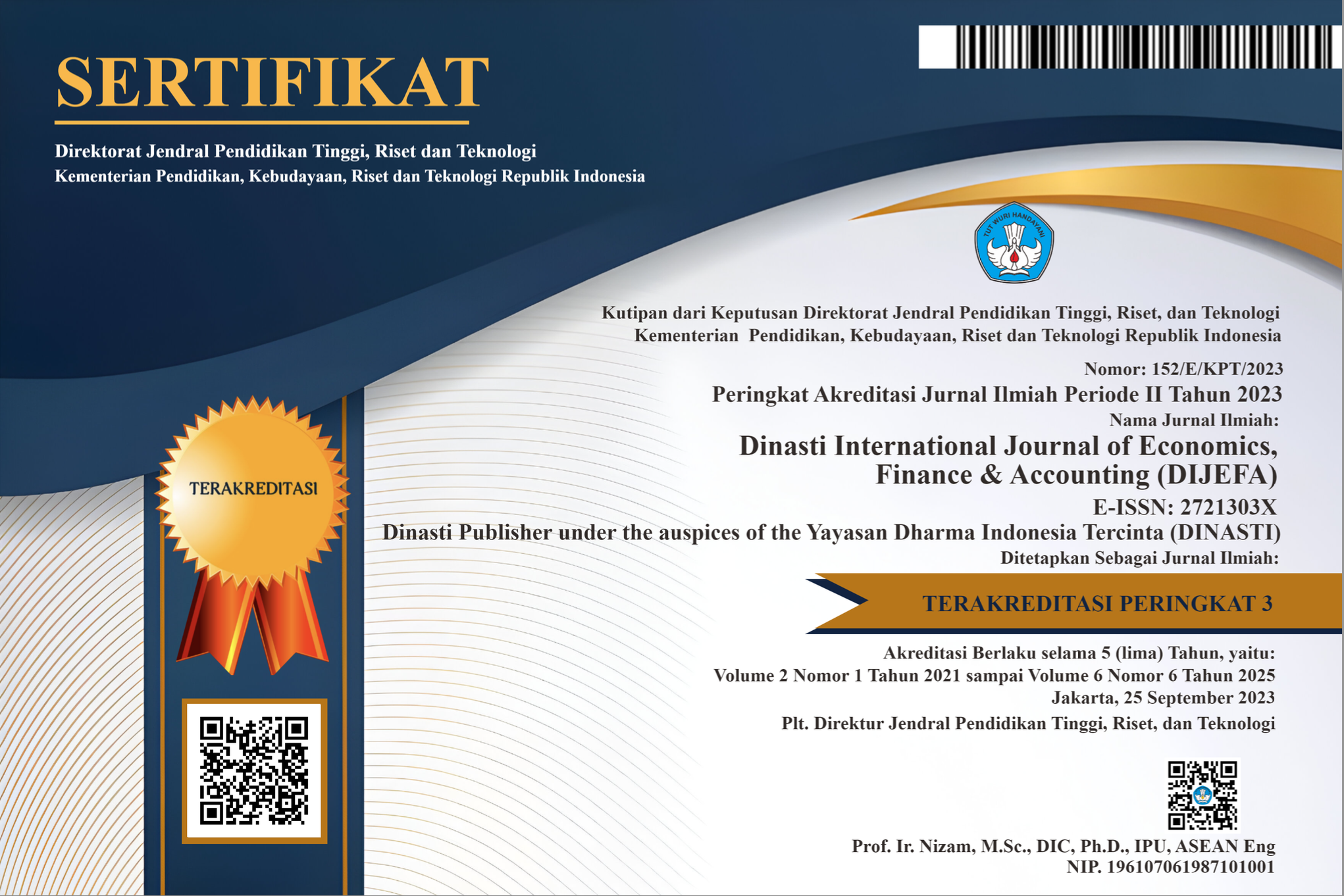The Key Determinants of Brand Loyalty in Indonesia's Cosmetics Market
DOI:
https://doi.org/10.38035/dijefa.v6i1.4056Keywords:
brand loyalty, brand name, promotion, service quality, cosmeticsAbstract
The global annual spending on cosmetics is estimated to be around billions, with numerous industry players competing fiercely to expand their market share. Companies in the cosmetics sector aim to secure a leading position by fostering customer loyalty, which is closely linked to brand loyalty. As a result, brand loyalty becomes a crucial factor in achieving success in a highly competitive market. This study investigates the impact of brand loyalty on the purchasing behavior of female consumers in Jakarta, the capital city of Indonesia. The research focuses on seven aspects of brand loyalty: brand name, product quality, price, design, promotion, service quality, and store environment. This study utilizing descriptive analysis, factor loading, and multiple regression methods to tested its hypotheses. Data was collected through self-administered questionnaires distributed to 125 female respondents who regularly use cosmetics. The findings revealed a strong correlation between promotion and brand loyalty. Additionally, the results demonstrated a positive and significant relationship between the factors of brand loyalty (brand name, product quality, price, design, promotion, service quality, and store environment) and loyalty to cosmetic brands.
References
Abraham, M.L. and Littrell, M.A. (1995). Consumer’s conceptualization of apparel attributes, Clothing and Textile Research Journal, 13(2), 65-74.
Anatasia, V., Sunitarya, & Adriana, V. (2016). The Effects of Advertising Strategies on Consumer Trust: A Case of Skin Care Products in Taiwan. Binus Business Review, 7(2), 125-130.
Bloemer, J. M. M., & Kasper, H. D. P. (1995). The complex relationship between consumer satisfaction and brand loyalty. Journal of Economic Psychology, 16(2), 311–329.
Cadogan, J.W. and Foster, B.D. (2000). Relationship Selling and Customer Loyalty: AnEmpirical Investigation. Marketing Intelligence & Planning, 18 (4), 185-199.
Clow, M. (2010). Integrated Marketing Communications. Pearson Education, Inc. publishing as Prentice Hall.
Chaudhry, M. D. (2008). Cosmetic industry achieves big growth in the region. Khaleej Times, 22 April.
Chaudhuri, A., Holbrook, M.B. (2001). The Chain Effect From Brand Trust and Brand Affect to Brand Perfomance: The Role of Brand Loyalty. Journal of Marketing, April.
Datta, P.R. (2003). The Determinants of Brand Loyalty. The Journal of American Academy of Business, 3, 138-144.
Day, W.F. (1969).Radical Behaviorism in Reconciliation With Phenomenology. Journal of The Experimental Analysis of Behavior, 12(2), 315-328
De Ruyter, K., Wetzels, M., & Van Birgelen, M. (1999). How do customers react to critical service encounters?: A cross-sectional perspective. Total Quality Management, 10(8), 1131–1145.
Duff, M. (2007). Niche Marketing of cosmetics. DSN Retailing Today, 38, 29-35.
Evans, M., Moutinho,L. and Raaij, W.F.V. (1996). Applied consumer behavior, Addison-Wesley Pub. Co.,Harlow; Reading, Mass.
Frings, G. S. (2005). Fashion: From Concept to Consumer (8th Ed.). New Jersey: Pearson/Prentice Hall.
Hameed, S. & Kanwal, M. (2018). Effect of Brand Loyalty on Purchase Intention in Cosmetic Industry. Research in Business and Management, 5(1), 25-35
Ha, H., John, J., Janda, S. and Muthaly, S. (2011). The effects of advertising spending on brand loyalty in services. European Journal of Marketing, 45 (4), 673-691.
Huang, M.H., & Yu, S. (1999). Are consumers inherently or situationally brand loyal?—A set intercorrelation account for conscious brand loyalty and nonconscious inertia; Psychology & Marketing, 16 (6), 523-544e
Keller, K. L. (2003). Strategic Brand Management: Building, Measuring and Managing Brand Equity. New Jersey: Prentice Hall.
Khraim, D. H. (2011). The Influence of Brand Loyalty on Cosmetics Buying Behavior of UAE Female Consumers. International Journal of Marketing Studies, 3(2), 123-133
Kotler, Keller. (2009). Manajemen Pemasaran. Penerbit Erlangga. Jakarta
Lau, M., Chang, M.T., Moon, K.L., & Liu, W. (2006). The brand loyalty of sportswear in Hong Kong. Journal of Textile and Apparel, Technology and Management, 5 (1).
Lee, J., Lee, J. and Feick, L. (2001), "The impact of switching costs on the customer satisfaction?loyalty link: mobile phone service in France", Journal of Services Marketing, 15(1), 35-48.
Lee, M., & Lee, E. (1997). A study on appearance interest and self-confidence of elderly women associated with demographic variables. The Korean Society of Clothing and Textiles, 21, 1072-81.
Leung, Chun-sun and To, Chester Kin-Man. (2001). Service-enhanced Manufacturing: A Study of Perceived Service Quality of Apparel Manufacturers. Journal of Fashion Marketing and Management, 5 (4), 313-323.
Levy, S.J.and Rook, D.W. (1999). Brands, consumers, symbols, & research: Sidney J. Levy on marketing, Sage Publications, Thousand Oaks, Calif.
Lin, M.Y and Chang, L.H. (2003). Determinants of Habitual Behavior For National and Leading Brands in China. Journal of Product & Brand Management, 12 (2), 94-107.
Lovelock, C. H. (2010). Services Marketing, (4th ed), New Jersey: Prentice Hall.
Malhotra, N. K. (2007). Marketing Research: An Applied Orientation (5th ed). New Jersey: Pearson PrenticeHall.
Mattila, Anna S and Witz, Jochen. (2008). The Role of Store Environmental Stimulation and Social Factors on Impulse Purchasing. Journal of services Marketing, 22(7), 562-567.
Milliman, Ronald E. (1982). Using Background Music to Affect The Behavior of Supermarket Shoppers. Journal of Marketing, 46, 86-91.
Mintel. (2011). Cosmetics; When It Comes To Cosmetics, Upper Income Shoppers Can Still be Thrifty. Marketing Weekly News.
Mittal,B. and Lassar, W.M. (1996). The role of personalization in service encounters, Journal of Retailing, 72(1), 95-109.
Moisescu, O.I. and Allen, B. (2010). The Relationship Between The Dimensions of Brand Loyalty, An Empirical Investigation Among Romanian Urban Consumers. Management & Marketing Challanges for Knowledge Society, 5(4), 83-98.
Monroe, Kent B. (1973). Buyers’ Subjective Perceptions of Price. Journal of Marketing Research, 10 ,70-80.
Oliver, Richard L. (1999). Whence Consumer Loyalty. Journal of Marketing, 63, 33-44.
Pefindo. (2011). Mustika Ratu Tbk. Equity & Index Valuation.
Reichheld, F.F. and Sasser, E. (1990). Zero Defections: Quality Comes to Services. Harvard Business Review, 68, 105-111.
Russell, R. S., & Taylor, B. W. (2006). Operation Management: Quality and Competitiveness in a Global Environment (5th ed). New Jersey: John Wiley & Sons, Inc.
Ryan, M.J, Rayner, R, & Morrison, A. (1999). Diagnosing Customer Loyalty Drivers. Marketing Research, 11 (2), 18-26.
Sander, O.A & Riza, F.(2016). Pengaruh kesadaran merek ritel, asosiasi merek ritel, kualitas yang diterima merek ritel, kesetiaan merek ritel terhadap ekuitas merek ritel (studi empiris pada kartika sari). Business Management Journal, 12(2).
Shaharudin, M. R., Anita, A., Suhardi, W., Shamsul, J., Etty, H., & Nurazila, A. (2010). The Relationship Between Extrinsic Attributes of Product Quality with Brand Loyalty on Malaysia National Brand Motorcycle/Scooter. Canadian social science, 6, 170-182.
Sproles, G. B., & Kendall, E. L. (1986). A methodology for profiling consumer decision -making design. The Journal of Consumer Affairs, 20, 267-279.
Sum, Cheng Yu & Hui, Chi Leung. (2009). Salespersons’ service quality and customer loyalty in fashion chain stores. Journal of Fashion Marketing and Management, 13 (1), 98-108.
Underwood, R. L. (2003). The Communicative Power of Product Packaging: Creating Brand Identity via Lived and Mediated Experience. Journal of Marketing Theory and Practice, 11(1), 62–76.
Whittaker, K. (2007). [Online] Available: http://cosmeticsuniverse.com/.
Wilson, N., and Keni, K. (2018). Pengaruh website design quality dan kualitas jasa terhadap repurchase intention: variabel trust sebagai variabel mediasi, Jurnal Manajemen dan Pemasaran Jasa, 11(2). 291-310.
Wong, f. Y., & Yahyah, S. (2008). Influence of Brand Loyalty on Consumer Sportswear. Int. Journal of Economics and Management, 2, 221-236.
Yim, Chi Kin & Kannan, P. K. (1999). Consumer Behavioral Loyalty:: A Segmentation Model and Analysis, Journal of Business Research, 44(2), 75-92.
Yoon, Sung-Joon & Kim, Joo-Ho. (2000). An Empirical Validation of a Loyalty Model Based on Expectation Disconfirmation. Journal of Consumer Marketing, 17 (2), 120-136.
Downloads
Published
How to Cite
Issue
Section
License
Copyright (c) 2025 Velly Anatasia, Tannia Tannia, Alexander Robert, Livia Evangelina Florencia

This work is licensed under a Creative Commons Attribution 4.0 International License.
Authors who publish their manuscripts in this journal agree to the following conditions:
- The copyright on each article belongs to the author(s).
- The author acknowledges that the Dinasti International Journal of Economics, Finance & Accounting (DIJEFA) has the right to be the first to publish with a Creative Commons Attribution 4.0 International license (Attribution 4.0 International (CC BY 4.0).
- Authors can submit articles separately, arrange for the non-exclusive distribution of manuscripts that have been published in this journal into other versions (e.g., sent to the author's institutional repository, publication into books, etc.), by acknowledging that the manuscript has been published for the first time in the Dinasti International Journal of Economics, Finance & Accounting (DIJEFA).


























































